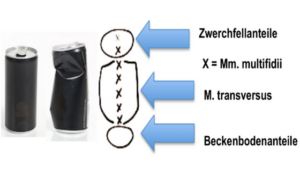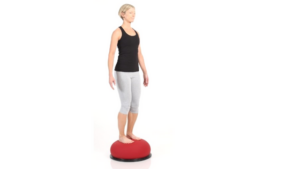1.1 Definition
- Sensor system:
- Absorption of information from the environment and its transmission to the central nervous system.
- Motor activity:
- Control and the resulting tension of the musculature.
-> Sensorimotor function is an interplay between the reception and processing of sensory information and the reaction of the musculature and the musculoskeletal system to this information.
Motor processes are controlled and modified by sensory feedback
Together with fasciae, muscles form a supporting structure that keeps our body in balance. If this connection is disturbed, it comes to the dysbalance, to the bad posture! (Here pictorially represented on the basis of a can)

1.2 Deep musculature – local stabilizers
- The deep layer of the abdominal muscles, the transversus abdominis muscle (transverse abdominal muscle), helps with the abdominal press, shapes the waist, it fixes our organs and is also called the deep abdominal muscle.
- The deep layer of the back muscles consists of many small muscles, the M. multifidii:
If the small muscles around the vertebral bodies are stretched by minimal rotations of the spine (for example, chopping movements with the forearms), the muscles tense reflexively..
- The pelvic floor musculature
By triggering the deep muscles with stimuli from outside, our pelvic floor muscles become involuntarily active.
The use of the pelvic floor muscles causes a concatenation of the following muscle groups: Deep stabilizers, deep transverse abdominis, deep fibers of the dorsal extensor, adductors on the inner thigh, ischiocrural muscles on the back of the thigh, piriformis muscle as an external rotator, the hip flexor, the diaphragm, fixators of the shoulder girdle, cervical muscles, masseter muscle (adapted from “Gymnastics for the Pelvic Floor,” Häflinger, 1999, p. 26).
- The stabilizers are short, mostly single-jointed, work tonically, become active independent of movements, cause even minimal movements in the joint systems, and stabilize the joints in their neutral zone (neutral zone = possible amplitude of movement of a joint in the rest position). They are responsible for controlling joint movements.
- When we move in everyday life, our stabilizers tense 50-125 milliseconds before the mobilizers (source: Albrecht, 2006).
- Without this preparation and cooperation of the deep muscles, the mobilizers would not be able to fully develop their strength.
- But through our everyday behavior, and the associated sparing of the muscles, the deep layers unlearn the coordinative ability to tense in time!
- This means faster wear and tear for our joints and the risk of incorrect loading.
-> The best way to achieve the activation of the deep muscle layers is through sensorimotor training!
1.3 Sensory-motor system
1. Level: Information
This is where the transmission of impulses from the sensory organs to higher cerebral centers takes place, as well as the awareness and processing of perceptions. The subarea can in turn be divided into two different areas:
Exteroception (extereo (lat.) = from outside): Exteroception refers to the reception and transmission of information from the environment by so-called exterosensors. These pick up stimuli from our environment; for example: Sight, hearing, taste, smell, pressure, vibration, pain, sensation of heat and cold.
Proprioception (proprius (lat.) = own; recipere (lat.) = to take in). Proprioception refers to the perception of body movement and position in space (Buser et al. 2007). Proprioceptors can be used to detect the position of the body in space as well as information about muscle tension, muscle length, joint position, and joint movement. Proprioceptors include muscle spindles, Ruffini corpuscles, Vater-Pacini corpuscles, and the Golgi tendon organs.
2. Level: Processing
The processing of sensations can take place on the one hand via central nervous processing processes and on the other hand via spinal reflexes. Here, motor reflexes are important components of movement control (fixation of joint positions, muscular readiness for activity, protection against morphological overload).
3. Execution
- BInvolves the control of voluntary movements and adaptation of muscle activities to environmental conditions. Movement processes can be divided into target motor activity and support motor activity. Target motor activity mainly involves the distal musculature, which is responsible for fine movements. The movement is planned. therefore it is also called voluntary motor activity. The supporting motor system mainly includes the proximal musculature (trunk or axial musculature), whose innervation is determined by proprioceptive inputs. These movement components are largely involuntary (reflex). Therefore, one also speaks of reflex motor activity.
- Training with unstable aids particularly improves sensorimotor function!
- We learn to process internal and external stimuli in the central nervous system faster and improve our coordination, i.e. both the cooperation of the deep lying muscle groups with the superficial muscle groups and the coordination of the individual muscle fibers within a muscle.
- This means for us in everyday life and for other sports:
 – improved balance,
– improved balance,
– better reaction speed,
– improved posture,
– Improved movement and motion control,
– improved strength capacity and
– improved thinking ability.
The best way to test the sensorimotor skills of your participants is to have them stand on an unstable surface, for example on the Jumper, and briefly close their eyes! Really only briefly! In the beginning, after 3 seconds, hardly any participant will be standing on the Jumper. After just a few training sessions, your participants will see great progress. This is a very nice and short AHA exercise to convince newcomers of the importance of sensorimotor training.
Stimulus processing in sensorimotor training
1.4 What is sensomotoric training?
- Sensorimotor training is a coordinative training to improve posture and movement sequences. The training effect results from the simultaneous processing of additional stimuli while the musculature is already busy performing another posture and movement program.
- Targeted training of sensorimotor functions leads to training and improvement of the:
– Deep sensitivity and body awareness
– Postural control
– Reflex activities
– Everyday and sport motor movement sequences (locomotion)
– Inter- and intramuscular coordination
– Static and dynamic balance, stability
- Sensorimotor training is mainly used in therapy, after operations or (sports) injuries. However, the preventive aspect/effect of sensorimotor training should not be ignored. Especially in sports, both competitive and recreational, sensorimotor training should be firmly integrated into the training routine to compensate for muscular imbalances and prevent injuries.
- A sensomotoric training should be built up gradually with regard to the requirement and be increased progressively
1.5 Practical experience
Note old people, they often get a “third leg” to go with them, such as a walking stick, to help them stand more securely on their feet.
But young people are also usually comfortable and don’t like to be exposed to the tilt for too long.
To avoid the “uncomfortable”, you sit down or support yourself with one hand to be statically safe again with three body parts.
Use this knowledge in your courses and modify only exercises, play with this knowledge about stability. It is often enough to just lift yourself up on your toes, put your feet on an Aero-Step, lift one leg off, put a ball under one knee… Every “tried and true” exercise becomes a new challenge! It is a workout that requires concentration and trains reflexes..
Thus, sensorimotor training is an important building block in training and makes any old exercise more intense, valuable and interesting.










